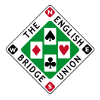
Dimmie Fleming, died aged 85 in 1996, was for almost 20 years ‘Mrs Bridge’, running the English Bridge Union from her home, as secretary from 1955 to 1974. She was only the second woman to play in a British open team.
It’s not surprising that Dimmie spent a restless night before her first open match in Helsinki in the summer of 1953. She dreamed that she and her partner, Peter Swinnerton-Dyer (later Professor Sir Peter Swinnerton-Dyer of Cambridge University, donor of the Baby Tollemache trophy), had bid a grand slam on the first board. The next day when they sat down to play their match in the European Open Championships they bid to a vulnerable grand slam in clubs, which made. In the other room, their Norwegian opponents only bid the small slam.
Non-playing captain Reg Corwen was not impressed. He had given the pair strict instructions to play down the middle and, as punishment for their boldness, replaced them after the first match.
No-one today would recognise Dimmie by her given name of Phyllis Irene. In her first year at prep school, boys names were all the rage and she became known as Jimmy. Fashion changed the following year and all the girls took nick-names beginning with the letter D. Her best friend Dorothy Pearson (later to become a regular bridge partner) turned ‘Jimmy’ into ‘Dimmie’.
Dimmie’s father, Stanley Paris Hill, was proprietor and headmaster of Eversley Boys Preparatory School in Tunbridge Wells. Her mother Cathrina Elizabeth was Norwegian. Dimmie, born in 1910, was their only surviving child.
Dimmie learned Auction bridge at her father’s school but when, at the age of nine, she transferred to an all-girls prep school, she lost interest. It was not until she was nineteen, recovering from an appendix operation, that the game entered her life again. In the hospital she met a young man who had played Contract bridge in America. He taught her Culbertson’s system and she was hooked.
She played quietly in Tunbridge Wells, making it to the West Kent ‘B’ team, but was not considered good enough for the ‘A’ team until England international Graham Mathieson spotted her potential and began to coach her. In 1934 she married another West Kent league player, Arthur Fleming, who was nineteen years her senior.
In 1939 she took part in the women’s trials for the international championships to be held in the Hague. She won a place, not with the team she entered, but with Elizabeth Corke’s team which won the trials. Her international career had begun. But the war effectively ended competitive bridge. Dimmie’s job with London stockbrokers ended and she spent the war years working as a farm secretary and caring for daughter Sheila, born in 1943. In 1947, with Rixi Markus, Kenneth Konstam and Edward Rayne, she won the first post-war European Championship Teams at Deauville where, she said, “the outstanding feature was the ball dresses of the French ladies. It was as though the pages of Vogue had sprung into life”.
Honours came to Dimmie year after year: Crockford’s in 1949 & 1950, the Lady Milne and Whitelaw Cup in '51, '53, '58 & '59; the Gold Cup in 1950; the Portland (with her husband) in 1953; the European Women’s Teams Championships in '51, '52, '59 & '63, and the Women’s World Team Olympiad in 1964.
While she was the EBU secretary membership grew from 4,000 to 9,000. In the early days she was able to recite any member’s address from memory. To most ordinary members, Dimmie Fleming WAS the EBU.
She gave up the position when the EBU moved into offices in Thame, but continued as secretary of the Laws and Ethics Committee until 1985. Since 1977 she had been a vice-president of the EBU, and every year awards are made in her honour to members who have significantly contributed to bridge in this country.
Dimmie became an enthusiastic convert to the Precision Club system and she persuaded Vida Bingham to learn Precision, and a new partnership - her last - was formed. One of Dimmie’s greatest pleasures, when she was over 70, was playing with Vida for England in the Lady Milne in 1980 & '81.
The Binghams and the Flemings had been friends for some time. The two women shared a common interest in National Hunt racing, and Vida’s husband was the Flemings’ accountant. After Leslie Fleming died in 1980, Vida and Dimmie ran his bridge stationery business together until 1987, when they sold it. They designed the famous Fleming board used in national competitions and many clubs all over the country.
Dimmie’s eyesight and memory began to fail in the mid-eighties and she moved into Vida’s home in East Sussex.
Those who knew Dimmie at her peak will remember a neat, slim and attractive woman, a little over medium height, with a warm voice and what one colleague described as a ‘cute’ laugh when she became animated and excited. Her hair, grey before she was forty, turned completely white as she grew older. She was teetotal and never smoked.
Peter Donovan, who worked with her during the Daily Mail’s sponsorship of the Schools Cup, admired her many gifts. “She was a very sweet person,” he says, “Terribly diligent and totally dedicated in what she did for the EBU.”
Major International Appearances
European Championships (open team): 1953
European Championships (women's team): 1939 1948 1949 1951* 1952* 1954 1958 1959* 1962 1963* 1970 and 1971
World Olympiad (women's team): 1960 and 1964
* = 1st place
Camrose Trophy Selections: 1952
Lady Milne selections: 1951 1953 1958 1959 1970 1972 1973 1980 and 1981
Gold Cup Winner: 1950
Crockfords Winner: 1949 and 1950
